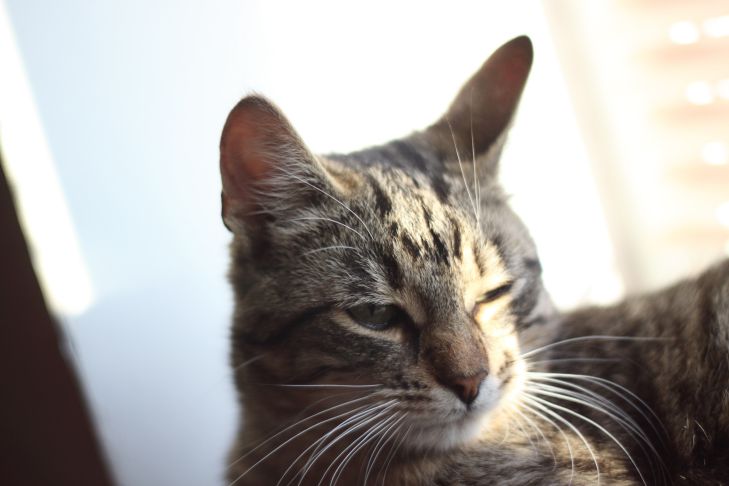Cats are naturally timid animals.
Often it is the natural instinct to flee and survive that is the reason for their initial distrust of change.
However, bad experiences from the past can also cause cats to become particularly fearful.
If you have an anxious cat at home who prefers to hide somewhere, then read the following recommendations.
Before you can help your anxious pet, you need to find out the reason for his fear.

Once the trigger has been identified, the best thing to do is to eliminate it. You can also develop coping mechanisms to help your cat cope with the situation. So what are cats most afraid of?
Cats do not like changes. Situations such as moving, a new home create stress for a cat.
Strangers or animals - as soon as the doorbell rings, the cat hides and panics.
If there are guests in the house, she prefers to hide all the time until the situation becomes clear. Even when a new cat or, for example, a dog appears in the house, the cat can get scared.
Loud or sudden sounds also frighten cats greatly. These animals have very good hearing and are always on the alert.
It is unlikely that any cat likes its transport box, which is sometimes simply necessary, for example, for a visit to the vet.
Visiting the vet is a huge panic for cats. Vets have a hard time, too.
Almost every treatment or examination requires that the pet be held. Also, some procedures in the veterinary clinic can be quite painful. All this leads to a negative experience.
Bad experiences with people - If you adopt a cat that has lived with other people before, there is a risk that the cat will develop a distrust of people due to poor treatment. This often happens with cats from animal shelters.
However, it is not always about beatings and other forms of violence. Incorrect treatment of the animal can also have a negative impact on the cat's trust. An example is excessive scolding or lifting the cat by the collar.
Recommendations for cat owners:
Calmness and patience are essential when dealing with a fearful cat.
If your cat is anxious, your attitude is often important. Be calm and gentle. For example, loud and sudden noises, such as slamming doors or loud music, should be avoided if possible. Consider these factors if you have a fearful cat in your home.
Space and shelter for a restless cat
An anxious cat should always have enough space to retreat. The cat should always have the opportunity to leave a tense situation. Hidden places can help here. This could be, for example, a crack in the sofa or a small place in the closet.
Cats do not need a large space for hiding, they will find it even in small rooms. It is important to respect the given place where the cat hides and not to touch it.
If your cat has just moved into a new home, she may want to hide from everyone for a few hours to a few days.
If your cat is hiding for a long time, you need to make sure that it still has free access to water, food and a litter box.
Using speech to calm an animal
There are many ways to use words and the right facial expressions to calm an animal. For example, you can talk to your cat slowly and calmly.
Slow blinking can show the animal that you are speaking well of it. It is a way for cats to smile.
However, prolonged eye contact should be avoided. Looking directly into the eyes can increase anxiety as it can be interpreted as aggressive behavior.
Long conversations with the animal can also help to strengthen the existing bond with the cat. It is helpful to speak calmly, in as low a voice as possible.
Strengthening relationships through shared games
Playing with your cat will help her build trust in you. Use your cat's natural instincts to play with her. Cats love to watch and hunt. For this, you can use special cat toys, a slicker brush, or various small balls.
It is useful for anxious cats to keep a sufficient distance at this point. This can be done, for example, with a cat trap. Or you can try a small ball that rolls past.
It's okay if your cat doesn't start playing right away; even watching the ball roll can be considered successful.
Careful touches
Many cat owners would like to calm their frightened cat by petting or picking it up. But even if this is done with the best of intentions, you should always wait until the cat is ready for contact.
Otherwise, the animal may feel depressed, which may increase fear. Fear may turn into aggression. At the same time, many cats do not like being picked up by a person.
By lifting your cat off the floor, you are taking away her control over the situation and her ability to easily escape.
Homeopathic Remedies: Bach Flowers for Anxious Cats
Another way to help an anxious cat is to use Bach flowers. This is a homeopathic form of treatment that uses specific Bach flower essences to address behavioral issues and special life situations.
Each Bach flower is believed to have a specific principle of action.
Combining several substances is thought to help people better cope with their feelings and fears. Among the Bach essences that are particularly often used to treat anxious cats are aspen (Quaking Poplar) and mimulus (Jongler's Flower).
Contact your veterinarian if your pet is very scared or has persistent fear.
If your cat's anxiety is persistent or excessive, you should consult a veterinarian or other specialist.
This is because constant anxiety can have negative consequences for the cat's health, body, and psyche. Anxiety can be recognized, for example, by raised ears or dilated pupils. Veterinarians have additional ways to calm an anxious cat. Do not delay.
Previously we explained why cats sleep at a person's feet.








